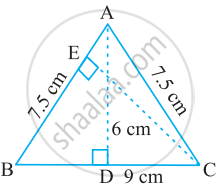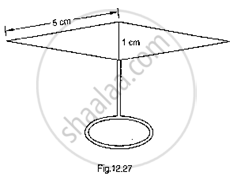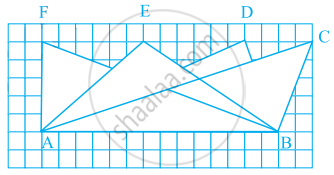Advertisements
Advertisements
प्रश्न
If the coordinates of the mid-points of the sides of a triangle are (3, 4) (4, 6) and (5, 7), find its vertices.
उत्तर
The co-ordinates of the midpoint `(x_m,y_m)` between two points `(x_1,y_1)` and (x_2,) is given by,
`(x_m,y_m) = (((x_1+x_2)/2)"," ((y_1+y_2)/2))`
`Let the three vertices of the triangle be `A(x_A,y_A), B(x_B, y_B)` and `C(x_C, y_C)`.
The three midpoints are given. Let `these points be `M_(AB)` (3,4), `M_(BC)` (4, 6)`and `M_(CA) (5, 7)`.
Let us now equate these points using the earlier mentioned formula,
`(3,4) = (((x_A + x_B)/2)"," ((y_A + y_B)/2))`
Equating the individual components we get,
`x_A + x_B = 6`
`y_A + y_B = 8`
Using the midpoint of another side we have,
`(4,6) = (((x_B + x_C)/2)","((y_B + y_C)/2))`
Equating the individual components we get,
`x_B + x_C = 8`
`y_B + y_C = 12`
Using the midpoint of the last side we have,
`(5,7) = (((x_A + x_C)/2)","((y_A + y_C)/2))`
Equating the individual components we get,
`x_A + x_C = 10`
`y_A + y_C = 14`
Adding up all the three equations which have variable ‘x’ alone we have,
`x_A + x_B + x_B + x_C + x_A + x_C = 6 + 8 + 10`
`2(x_A + x_B + x_C) = 24`
`x_A + x_B + x_C = 12`
Substituting `x_B + x_C = 4` in the above equation we have,
`x_A + x_B + x_C = 12`
`x_A + 8 = 12`
`x_A = 4`
Therefore,
`x_A + x_C = 10`
`x_C = 10 - 4`
`x_C = 6`
And
`x_A + x_B = 6`
`x_B = 6 - 4`
`x_B = 2`
Adding up all the three equations which have variable ‘y’ alone we have,
`y_A + y_B + y_B + y_C + y_A + y_C = 8 + 12 + 14`
`2(y_A + y_B + y_C) = 34`
`y_A + y_B + y_C = 17`
Substituting `y_B + y_C = 12` in the above equation we have
`y_A + y_B + y_C = 17`
`y_A + 12 = 17`
`y_A = 5`
Therefore
`y_A + y_C = 14`
`y_C = 14 - 5`
`y_C = 9
And
`y_A + y_B = 8`
`y_C = 14 - 5`
`y_C = 9`
And
`y_A + y_B = 8`
`y_B = 8 - 5`
`y_B = 3`
Therefore the co-ordinates of the three vertices of the triangle are A(4,5), B(2,3), C(6,9)
APPEARS IN
संबंधित प्रश्न
Find the area of the triangle whose vertices are: (–5, –1), (3, –5), (5, 2)
Find the area of a triangle with vertices at the point given in the following:
(2, 7), (1, 1), (10, 8)
ΔABC is right angled at A (see the given figure). AD is perpendicular to BC. If AB = 5 cm, BC = 13 cm and AC = 12 cm, Find the area of ΔABC. Also find the length of AD.

ΔABC is isosceles with AB = AC = 7.5 cm and BC = 9 cm (see the given figure). The height AD from A to BC, is 6 cm. Find the area of ΔABC. What will be the height from C to AB i.e., CE?

Find the area of the blades of thc magnetic compass shown in Fig.. 12.27. (Take √11 = 3.32).

If the points (3, -2), (x, 2), (8, 8) are collinear, then find the value of x.
The area of the triangle whose vertices are A(1, 2), B(-2, 3) and C(-3, -4) is ______.
The area of a trapezium is 475 cm2 and the height is 19 cm. Find the lengths of its two parallel sides if one side is 4 cm greater than the other.
Find the missing value:
| Base | Height | Area of parallelogram |
| ______ | 8.4 cm | 48.72 cm2 |
Observe all the four triangles FAB, EAB, DAB and CAB as shown in the given figure.

- All triangles have the same base and the same altitude.
- All triangles are congruent.
- All triangles are equal in area.
- All triangles may not have the same perimeter.
